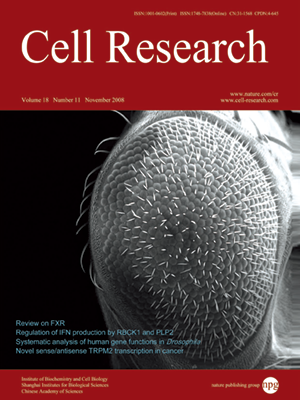
Volume 18, No 11, Nov 2008
ISSN: 1001-0602
EISSN: 1748-7838 2018
impact factor 17.848*
(Clarivate Analytics, 2019)
Volume 18 Issue 11, November 2008: 1105-1113
ORIGINAL ARTICLES
PLP2, a potent deubiquitinase from murine hepatitis virus, strongly inhibits cellular type I interferon production
Dahai Zheng1, Gang Chen1,3, Beichu Guo2, Genhong Cheng1,2 and Hong Tang1
1Center for Infection and Immunity, Institute of Biophysics, Chinese Academy of Sciences, 15 Da Tun Road, Chaoyang District, Beijing 100101, China;
2Department of Microbiology, Immunology and Molecular Genetics, University of California Los Angeles, Los Angeles, CA, 90095, USA;
3Graduate University of Chinese Academy of Sciences, 19 Yu Quan Road, Shijingshan District, Beijing 100049, China
Correspondence: Hong Tang, Genhong Cheng,(tanghong@moon.ibp.ac.cn; gcheng@mednet.ucla.edu)
Infections by coronaviruses such as severe acute respiratory syndrome (SARS) coronavirus (SCoV) and mouse hepatitis virus A59 (MHV-A59) result in very little type I interferon (IFN) production by host cells, which is potentially responsible for the rapid viral growth and severe immunopathology associated with SARS. However, the molecular mechanisms for the low IFN production in cells infected with coronaviruses remain unclear. Here, we provide evidence that Papain-like protease domain 2 (PLP2), a catalytic domain of the nonstructural protein 3 (nsp3) of MHV-A59, can bind to IRF3, cause its deubiquitination and prevent its nuclear translocation. As a consequence, co-expression of PLP2 strongly inhibits CARDIF-, TBK1- and IRF3-mediated IFN reporter activities. In addition, we show that wild-type PLP2 but not the mutant PLP2 lacking the deubiquitinase (DUB) activity can reduce IFN induction and promote viral growth in cells infected with VSV. Thus, our study uncovered a viral DUB which coronaviruses may use to escape from the host innate antiviral responses.
Cell Research (2008) 18:1105-1113. doi: 10.1038/cr.2008.294; published online 28 October 2008
FULL TEXT | PDF
Browse 1872


